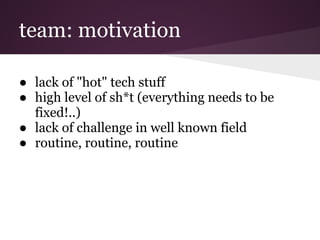RubyConfLT2012: Legacy / long running projects
- 1. Legacy / long running projects RubyConfLT 2012
- 2. def "A legacy system is an old method, technology, computer system, or application program that continues to be used, typically because it still functions for the users' needs, even though newer technology or more efficient methods of performing a task are now available." (Wikipedia)
- 3. def Long running: > 2 years
- 4. def Reality: long running =~ legacy
- 5. important! technology + team
- 6. important? technology + team manage ment
- 7. technology: upgrade worth total rewrite? =~ to be or not to be
- 9. technology: rewrite unless...
- 10. technology: rewrite ŌŚÅ 50% rule ŌŚÅ clear legacy system requirements ŌŚÅ new technology mature enough & team ready ŌŚÅ benefits/costs ratio ŌŚÅ customer understands what's going on (...)
- 11. technology: rewrite Good (famous) examples: ŌŚÅ Mac OS -> OS X ŌŚÅ Minix -> Linux ŌŚÅ PHP 1 -> PHP 2
- 12. technology: rewrite Good (famous) examples: ŌŚÅ Mac OS -> OS X ŌŚÅ Minix -> Linux ŌŚÅ PHP 1 -> PHP 2 ŌŚÅ UBB -> vBulletin ŌŚÅ Netscape -> Mozilla ŌŚÅ ...
- 13. technology: rewrite ŌŚÅ integration tests ŌŚÅ prioritize! ŌŚÅ be ready to support legacy system ŌŚÅ simplify ŌŚÅ migrate data early ŌŚÅ rewrite piece-by-piece ŌŚÅ usually takes longer than expected
- 14. technology: technical debt "Like a financial debt, the technical debt incurs interest payments, which come in the form of the extra effort that we have to do in future development because of the quick and [1] dirty design choice." [1] http://martinfowler.com/bliki/TechnicalDebt.html
- 15. technology: technical debt Main diff from short period projects: technical debt matters
- 16. technology: technical debt Main diff from short period projects: technical debt matters A LOT
- 17. technology: technical debt Impact on team & development speed
- 18. hard part: team As always with HR: difficult to measure
- 19. team: motivation ŌŚÅ lack of "hot" tech stuff ŌŚÅ high level of sh*t (everything needs to be fixed!..) ŌŚÅ lack of challenge in well known field ŌŚÅ routine, routine, routine
- 20. team: motivation side projects IS-A-MUST
- 21. team: motivation side projects IS-A-MUST even if forced
- 22. team: motivation hackathons startup weekends conferences
- 23. team: motivation scoped(freedom) to choose tech
- 24. team: technical debt pay your debt in time.
- 25. team: motivation collective code ownership at least weak code ownership
- 26. team: motivation adequate attention to non-tech problem solving (universal)
- 27. team: motivation if a product has some fans (hopefully), forward/communicate love letters to the team
- 28. return 1. technology matters as much as it matters to the TEAM 2. changes are and must be inevitable 3. way of recharging the batteries must be developed to get rid of long run exhaustion 4. ... 5. profit!
- 29. end +Vidmantas Kabo┼Īis @vidmantas vidmantas@kabosis.lt vidmantas.kabosis.lt slides: bit.ly/legacy-long-running-projects Questions?














![technology: technical debt
"Like a financial debt, the technical
debt incurs interest payments,
which come in the form of the extra
effort that we have to do in future
development because of the quick and
[1]
dirty design choice."
[1] http://martinfowler.com/bliki/TechnicalDebt.html](https://image.slidesharecdn.com/rubyconflt2012-legacy-long-running-projects-120504070202-phpapp01/85/RubyConfLT2012-Legacy-long-running-projects-14-320.jpg)














